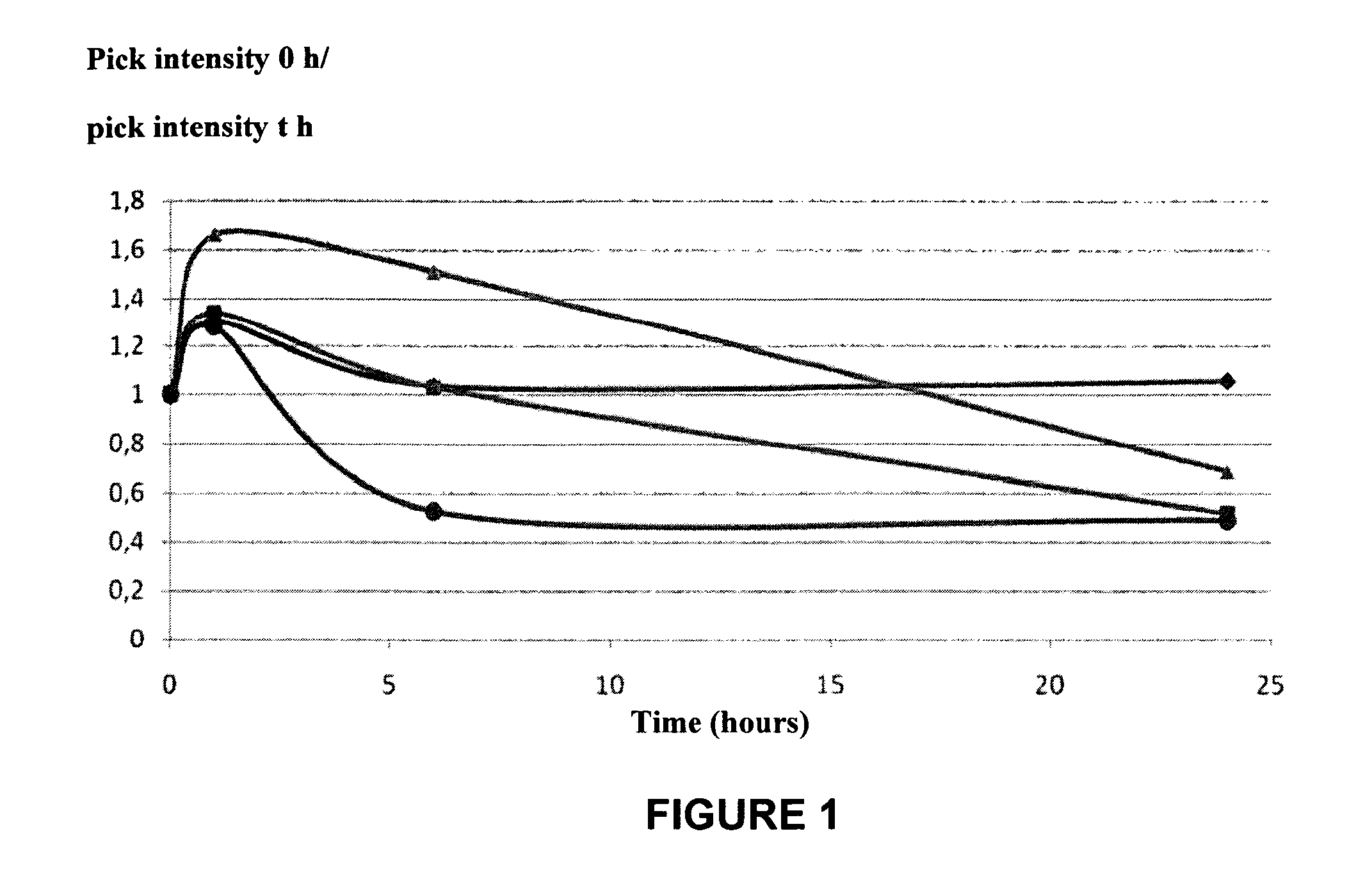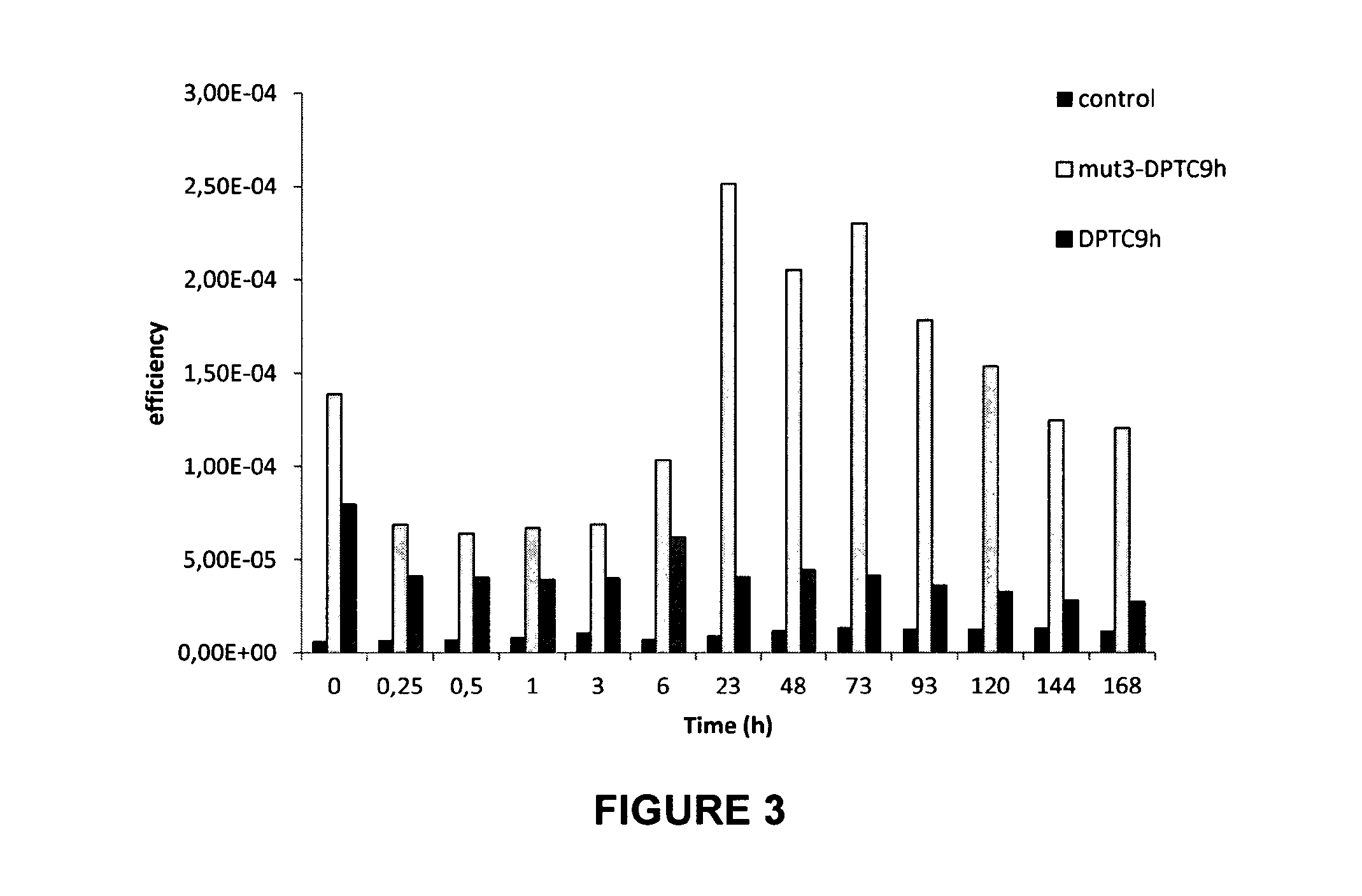Cell-penetrating peptides
a cell-penetrating and peptide technology, applied in the field of cell-penetrating peptides, can solve the problem of short half-life of peptides, and achieve the effect of reducing the dose of peptides injected
- Summary
- Abstract
- Description
- Claims
- Application Information
AI Technical Summary
Benefits of technology
Problems solved by technology
Method used
Image
Examples
example 1
Design and Characterization of Mutated Non-Degradable DPT-C9h Penetrating Peptides
[0138]1.1. Materials and Methods
[0139]Peptide Synthesis and Sequence
[0140]Peptides were synthesized in an automated multiple peptide synthesizer with solid phase procedure and standard Fmoc chemistry. The purity and composition of the peptides were confirmed by reverse phase HPLC and by amino acid analysis.
[0141]Analysis Peptide Stability in Human Serum
[0142]Analysis of peptides degradation was done by Proteominer and Maldi-Tof as previously described.
[0143]1.2. Results
[0144]DPT-C9h is VKKKKIKREIKI-YVETLDDIFEQWAHSEDL (SEQ ID NO:6),
[0145]The R residue was mutated to K (Mut1-DPT-C9h), N (Mut2-DPT-C9h) or A (Mut3-DPT-C9h).
[0146]FIG. 1 shows that Mut3-DPC-C9h peptide is not degraded upon 24 h of contact with the human serum. In addition, the other mutants showed a higher stability compared to control peptide (DPT-C9h).
example 2
Effect of Mutated DPT-C9h on Apoptosis
[0147]2.1. Materials and Methods
[0148]Cells
[0149]Human breast cancer HBCx-12A, cell line has been isolated from primary human cancer xenografts and was cultured in RPMI medium supplemented with 10% of FCS.
[0150]Detection of apoptosis by annexin-V-FITC staining Apoptotic cells were detected using Annexin-V (-FITC from BD biosciences) as described by the manufacturer. Briefly, the cells were washed in 1× binding buffer, centrifugated and then resuspended in 200 μl of 1× binding buffer containing Annexin V-FITC (0.1 μg / ml) and PI (0.5 μg / ml). After incubation at room temperature in the dark for 10 min, cells were analyzed by flow cytometry. Data acquired by FACSCalibur (BD biosciences) were analyzed with Cellquest Pro software.
[0151]2.2. Results
[0152]The inventors have then analyzed whether the mutated peptides retain the capacity to induce apoptosis. The breast cancer cell line HBCx-12A was treated for 24 h with 100 μM of the control and mutated p...
example 3
Biodistribution of Mut3DPT-C9h in Tumors
[0153]3.1. Materials and Methods
[0154]Peptide Synthesis and Sequence
[0155]Peptides (DPT-C9h and Mut3DPT-C9h) were synthesized as described above. The fluorochrome Cy5 was added during the synthesis of the peptide.
[0156]Fluorescence Assays
[0157]Mice were IP (intraperitonally)-injected with the peptide Cy5DPT-C9h or Mut3DPT-C9h (5 mg / kg) and then analyzed at different times after injection.
[0158]Fluorescence imaging was performed with the IVIS imaging system (IVIS100, Caliper Life Sciences, USA). Mice were anesthetized upon analysis. Imaging acquisition time was from 1 s to 10 s, depending on the fluorescence signal. Analysis was performed using software Living Image V. 2.50 (Caliper Life Sciences).
[0159]3.2. Results
[0160]Biodistribution of Mut3DPT-C9h and DPT-C9h in the breast cancer xenograft models.
[0161]The inventors were interested in analyzing and comparing the biodistribution of both peptides. FIG. 3 shows the biodistribution of Cy5DPT-C9...
PUM
| Property | Measurement | Unit |
|---|---|---|
| Fraction | aaaaa | aaaaa |
| Cell proliferation rate | aaaaa | aaaaa |
Abstract
Description
Claims
Application Information
 Login to View More
Login to View More - Generate Ideas
- Intellectual Property
- Life Sciences
- Materials
- Tech Scout
- Unparalleled Data Quality
- Higher Quality Content
- 60% Fewer Hallucinations
Browse by: Latest US Patents, China's latest patents, Technical Efficacy Thesaurus, Application Domain, Technology Topic, Popular Technical Reports.
© 2025 PatSnap. All rights reserved.Legal|Privacy policy|Modern Slavery Act Transparency Statement|Sitemap|About US| Contact US: help@patsnap.com



